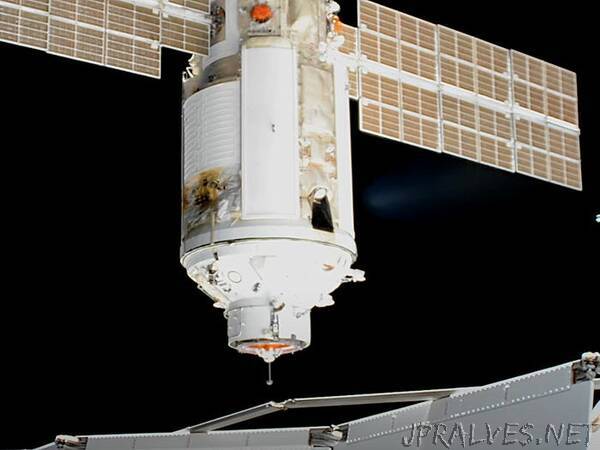
“A new Russian space-station module malfunctioned after it docked on Thursday. The module, called Nauka, starting unexpectedly firing its thrusters — which moved the entire station out of position.
The long-awaited science module had already encountered several technical issues on its way to the ISS, but once it docked to the space station on Thursday morning, it seemed to be in the clear. Then about three hours after its arrival — at about 12:34 p.m. ET — Nauka suddenly began firing its thrusters.
Astronauts on the ISS told flight controllers they were seeing something strange out their windows. Space journalist Anatoly Zak was among the first to notice their observations.
“Numerous particles are also seen outside the station indicating either major propellant leak or gas vent,” Zak tweeted.
In response to the glitch, flight controllers began firing thrusters on two other parts of the Russian side of the ISS, including the service module, in what they called a “tug of war” to get the station back into its normal position.
By 1:30 p.m. ET, ISS flight controllers announced that Nauka’s thrusters had finally stopped firing and they had regained control of the station’s positioning. Over that hour, Nauka had rotated the station by 45 degrees.
“All other station systems are operating perfectly,” NASA said Thursday afternoon. “None of the other appendages were damaged in any way.”
A sudden loss of control over the space station’s orientation is “not a common occurrence,” NASA said, adding that there are procedures in place to fix such an issue when it does arise. Occasionally, flight controllers deliberately change the ISS’s orientation to avoid oncoming space debris, or make it easier for a spacecraft to successfully dock at the station.
The ISS crew is not in danger and never was, according to flight controllers at NASA’s Johnson Space Center. Currently there are two cosmonauts, Oleg Novitskiy and Pyotr Dubrov, aboard the station, as well as and five astronauts: Akihiko Hoshide of the Japan Aerospace Exploration Agency, Thomas Pesquet of the European Space Agency, and Shane Kimbrough, Megan McArthur, and Mark Vande Hei of NASA.
“It’s safe to say the remainder of the day is no longer going to happen as scheduled, of course,” a flight controller told the ISS astronauts Thursday afternoon. Controllers asked them to check the station’s starboard, or right, side to see if there was any damage to the station’s exterior or floating debris.
So far, the astronauts have reported nothing amiss. They didn’t even feel the station moving during the incident, according to ISS program manager Joel Montalbano.
“You asked the crew, ‘Hey, did the space station shake or anything like that?’ And the response was negative,” he said during a briefing on Thursday afternoon.
Montalbano added that he’s “not too worried” given that the station’s maximum spin speed was about half a degree per second.
It’s not yet clear what caused the engines to fire out of turn. But Zak wrote that Russia’s mission control discovered a helium gas leak in one or two of Nauka’s tanks, which may have comprised the thrusters’ operation.
Around 2:15 p.m. ET, Russian flight controllers confirmed with NASA that they had disabled the errant thrusters.
Zak also reported that Nauka has used up all the propellant available to its thrusters, so there’s no chance of another “tug of war.”
Nauka, which is also known as the Multipurpose Laboratory Module (MLM), was originally scheduled to launch in 2007, but technical issues and unexpected repairs led to years of delay.
The module expands the Russian side of the ISS, adding more science facilities, crew quarters, and a new airlock for spacewalks. It also features a new docking port for Russian spacecraft.
But Nauka didn’t have a smooth journey into orbit. Shortly after launching on July 21, Nauka failed to fire its main engines and push itself to a higher altitude. Russian mission controllers had to instruct the 43-foot-long, 2.5-ton module to fire its backup thrusters to get back on course.
After Nauka successfully docked on Thursday, the two ISS cosmonauts started checking for leaks, preparing to open the module’s hatch, and integrating the module into the station’s power and computer systems.
But after the engines started firing, flight controllers advised the ISS crew to keep the hatch closed and to close the station’s 1.5-inch-thick windows.
NASA and Russia’s space agency, Roscosmos, will spend the next few days investigating the incident. Roscosmos will take the lead on analyzing Nauka, while NASA will focus on assessing space-station structures for any signs of damage.
“We’ll have a quick look done by the end of the day tomorrow,” Montalbano said. “That’ll tell us if we have any poke-outs that we’re worried about that we want to go and look at.”“
